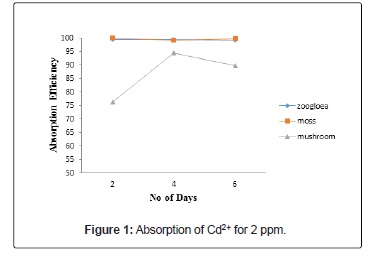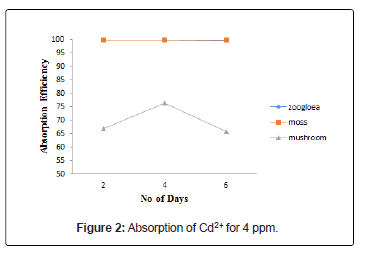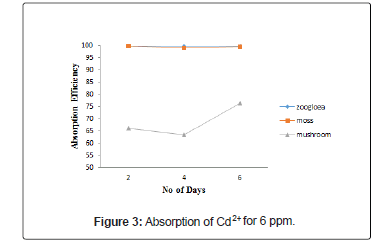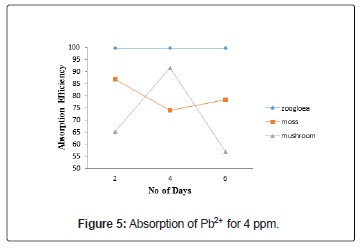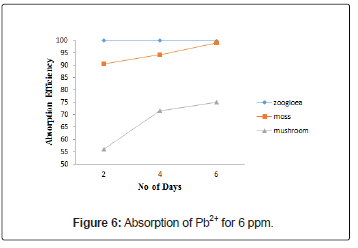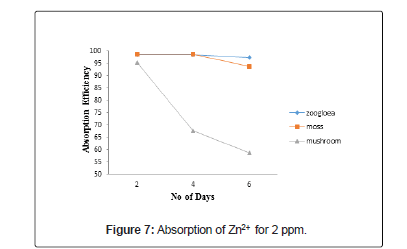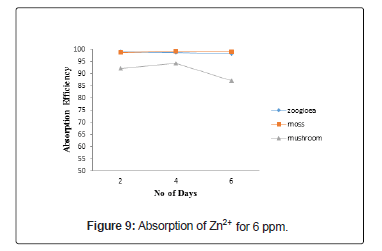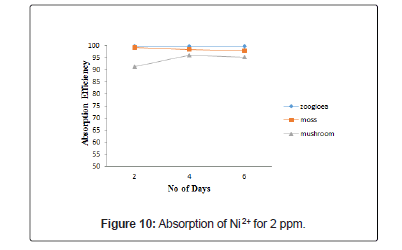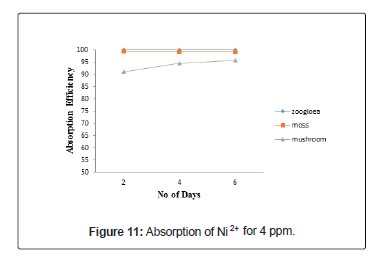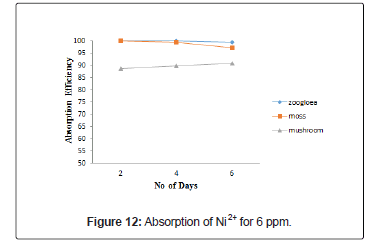Bioremediation of Heavy Metal Contaminated Aqueous Solutions Using Zoogloea Layer, Moss and Mushroom Cells
Received: 07-Sep-2021 / Accepted Date: 22-Sep-2021 / Published Date: 29-Sep-2021 DOI: 10.4172/2155-6199.1000008
Abstract
Quality of water is a vital issue that can affects the health impact of humans through pollution. Aquatic environment via anthropogenic and natural activities is of optimum concern. Hence, there is need to provide cost effective and environmentally eco-friendly technique of bioremediation. This study explored the absorption efficiency of living cells of zoogloea layer, moss and mushroom as bio-indicators to monitor pollution in aqueous solution contaminated with cadmium, lead, zinc and nickel. The microorganisms indicated appreciable abilityto survive in the heavy metals contaminated aquatic environment through homeostatic mechanism functions in the microbial cells to maintain mass balance for effective biological activities. The incubation processes were carried out in bio-treatment set up over a period of 48 hrs, 96 hrs and 144 hrs (2,4 and 6 days) at different varying metal concentrations. Zoogloea layer and moss showed higher retention capacity for Pb2+ and Cd2+ than mushroom because they are capable of metabolizing xenobiotics which makes the metals less toxic and remove the ions from solution. About 70% to 90% of the contaminated solutions that were analysed can be removed by living cells of the studied biomass materials. On the basis of the maximum absorption capacity, the order of affinity of the metal ions for the studied microorganisms was Ni 2+>Zn 2+ >Cd 2+ >Pb 2+ . These results suggest that zoogloea layer, moss and mushroom can successfully treat heavy metals concentrated solutions.
Keywords: Bioremediation; Zoogloea layer; Moss; Mushroom; Bio-degradable
Introduction
Growing urbanization and industrialization tend to accumulate bio-degradable and non- degradable waste to the environment that can generate soil, air and water pollution. There are quite number of contaminants that can be release into an ecosystem such as pesticides, herbicides, heavy metals and hydrocarbons. Among these contaminants, heavy metal pollution poses a major environmental and human health problem due to its toxicity by changing the oxidation state of species and form precipitate. The main sources of these trace metals are anthropogenic sources such as industrial effluents, bio solids, oil spillage, traffic and domestic emissions, weathering of building [1]. In many parts of the country, Nigeria, the water ecosystem has been excessively contaminated with some toxic heavy metals which need urgent mitigation measures. A large number of devised conventional methods like chemical precipitation, adsorption, coagulation, absorption, ion-exchange, complexation, dissolution have been used to remove heavy metals from aqueous solution [2,3]. Treatment of wastewater solution using solar activated plants (phytoremediation) and some microorganisms (bioremediation) have been documented in some literatures because is an eco-friendly and cost effective approach [4]. Phytoremediation is an ecological strategy that utilizes solar activated plants to promote the immobilization and sequestration of pollutants from the environment through physical, chemical and biological process [5,6] while bioremediation utilizes naturally occurring microorganisms such as bacteria, fungi and yeast to degrade hazardous substances into non-toxic substances in Figures 1-12.
Environmental pollution with lead accumulated in the body system can affect the gastrointestinal tract, kidneys and central nervous system. Children exposed to lead are at risk of impaired development, lower IQ, hyperactivity and mental deterioration [7]. The disposal of industrial wastes increases the concentration of Cd in the water bodies and its threat to human health is chronic accumulation that can lead to kidney dysfunction [8]. Zinc and Nickel enter the human body through the food chain. Contamination of zinc is through mining, refineries, brass manufacturing and plumbing with its toxic effect of short term “metal- fume fever” of gastrointestinal distress [9]. Nickel can lead to chronic bronchitis, reduced lung function, lung cancer, if consumed through untreated discharge from porcelain enamelling, non-ferrous metal, paint formulation, electroplating [10].
The utilization of plants and microorganisms for remediation of heavy metal contaminated solutions is a beneficial measures adopted this days. Zoogloea layer, moss and mushroom are among the best bio-indicators for this purpose due to their efficient mechanism of absorbing the trace metals. Zoogloea layer is a filamentous multicellular green plant that grows in aquatic habitat. It is a genus of gram negative aerobic, rod-shaped bacteria with chlorophyll as the only green pigment, a slim-lined body and cell wall joined end to end. Zoogloea layer plays a crucial role in wastewater treatment because of its ability to reduce demand for biological oxygen [11]. In that case it can be a good source of biomass material for absorption of metallic ions from an aqueous solution. Moss is a bryophyte and non-vascular simple plant that forms in damp or shady locations. Mosses have very thin under developed cuticle and their tissues are easily permeable to water and minerals including metallic pollutants. Their cell walls possess high exchange capacity which enables them to perform ion exchange from the surface through their cell membrane and even their dead tissues have capacity to bind ions [12]. They lack root system and depend largely on atmospheric deposition for the requirements of mineral elements. Mosses have been used to bioaccumulate pollutants in aquatic [13], air and terrestrial ecosystems because they have a great capacity for trace element retention [14,15]. Mushrooms are saprophytes that grow on dead organic matters such as fallen leaves, dead wood and plant roots. Fruiting bodies of the mushrooms are considered to be beneficial to plants it possess enzymatic machinery for the degradation of various substrate and pollutants [16,17] and can serve as biological filter for heavy metal clean up from solution. Mushrooms response to metal stress in the environment by producing stress compounds of proteinous and nonproteinous origin. The cap of the mushrooms has been found to produce stress related factors which govern in metal ion uptake, that is, metallothionein glutothionine, and plastocyanin [16]. Simple plants and microorganisms are widely use in biotechnology and molecular biology research. Thus the purpose of this present study is to ascertain the efficiency of zoogloea layer, moss and mushroom on progressive removal of heavy metals from contaminated solution.
Materials And Methods
The living cells of the microorganisms were collected from different locations in Anambra state. Zoogolea layer was harvested from ochichi stream in Abagana; moss was collected from a wall in Agu-Awka; mushroom was collected from the bush near police mobile base in Agu- Awka. The salts of Pb, Zn, Cd and Ni metals are all analytical grades i.e Pb(NO3)2, Cd(NO3)2, Zn(NO3)2 and NiCl3.6H2O.
Bioaccumulation experiment
Drained zoogloea layer (3 kg), moss (2 kg) and mushroom (3 kg) were placed in a petri-dish containing the different concentrations (2 ppm,4 ppm and 6 ppm) of the individual metallic ions. The biomonitoring analysis was incubated for 48 hrs, 96 hrs and 144 hrs (2, 4, 6 days) simultaneously at different level of concentrations. 20 mls aliquots of the different aqueous solutions were withdrawn at 48 hrs, 96 hrs and 144 hrs intervals which was filtered and digested with HNO3 and analysed in duplicates for Pb2+, Cd2+, Zn2+ and Ni2+ using Atomic Absorption Spectrophotometer (AAS). The average of the duplicates were calculated and the absorption efficiency (%) were evaluated using the formula

Where Co and Ce are the initial and final equilibrium concentrations
Results and Discussion
In the present study, the percentage removal of the metallic ions by biomass materials is shown on the graphs. When the lead and cadmium concentration increases from 2 ppm to 6 ppm, zoogloea and moss depict a high measurable assimiliation of the metallic pollutants as compared to mushroom. Lead and cadmium are among the most toxic trace metals that affect the intracellular parts of living organisms. With these findings it shows that the living cells of zoogloea and moss possess strong bonds available for the binding of the ions. Zoogloea layer which is a gram- negative bacteria have a very thin cell wall made of protein layer called peptidoglycan that easily permeates the pollutants and other nutrients through the cell membrane to internal cells. From the plots of Figures 1-12, all the living microorganisms showed high accumulation capacity for the Zn2+ and Ni2+ ions. Zinc and nickel are essential trace elements that are necessary for the growth and development of microorganism. Zinc activate the catalytic and structural components of protein; therefore microorganisms especially bacteria that incorporate the metal with their proteins are essential for DNA replication, pH regulation and glycolysis. The affinity of the metal ions is in the order of Ni2+>Zn2+>Cd2+>Pb2+ at different time intervals for the three microorganisms.
From the above graphical analysis, it can be deduced that the microbial cells (lntracellular) of the living zoogloea and moss can bio accumulate because they have high Pb2+ and Cd2+ tolerance and can effectively be used pollutant monitoring in both terrestrial and aquatic environment than mushroom. Moreover, both the living and dead cells of mushroom exhibit high level of biosorption than bioaccumulation due to the presence of negatively charged active sites available to bind metal ions through physicochemical mechanism.
Conclusion
This study showed that the living cells of zoogloea layer, moss and mushroom have the potential as bio-indicators on bioremediation of heavy metal contaminated solutions. The absorption capacity of moss and zoogloea layer for all the metallic ions is slightly higher than that of the mushroom. In some developing countries where there is rapid growing industrialization and urbanization that release toxic metallic pollutants to the environment, there is urgent need to develop eco-friendly and economical techniques for the remediation of the waste water solution. However, the use of the living cells of studied microorganisms to remove heavy metals from an aqueous solution is an efficient, sustainable and economically green bioremediation process that can be adopted.
References
- Tang X, Zhenze L, Yunmin C (2009) Adsorption Behavior of Zn(II) on Calcinated Chinese Loss. J Hazard Mater 161 (2-3): 824-834.
- Salt DE, Prince RC, Pickering IJ, Raskin I (1995) Mechanisms of cadmium mobility and accumulation in Indian mustard. Plant Physiol 109(4): 1427-1433.
- Sherena T (2010) Mobility and Transport of Heavy Metals in Polluted Soil Environment. Int J Biol 2(2): 112-121.
- Pooja M, Jyotsna K, Arun U, Jasdev B (2019) Assessment of Phytoremediation Potential of Chara vulgaris to Treat Toxic Pollutants of Textile Effluent. J Toxicol.
- Jing Y, He Z, Yang X (2007) Role of Soil Rhizobacteria in Phytoremediation of Heavy Metal Contaminated Soils. J Zhejiang Univ Sci B 8(3): 192-207.
- Shrestha P, Belliturk K, Görres JH (2019). Phytoremediation of Heavy Metal-Contaminated Soil by Switchgrass: A Comparative Study Utilizing Different Composts and Coir Fiber on Pollution Remediation, Plant Productivity, and Nutrient Leaching. Int J Environ Res Public Health 16: 1261.
- Umeh C, Jonnie NA, Kovo GA, Oyeka EE, Alfred EO (2019) Adsorption Properties of Tropical Soils from Awka North Anambra Nigeria for Lead and Cadmium Ions from Aqueous Media.
- Weggler K, Mclaughlin MJ, Graham RD (2004) Effect of chloride in soil solution on the plant availability of biosolids-borne cadmium. J Environ Qual 33(2): 496-504.
- Manohar DM, Krishnan KA, Anirudhan TS (2002) Removal of mercury (II) from aqueous solutions and chlor-alkali industry wastewater using 2- mercaptobenzimidazole-clay.Water Resour 36: 1609-1619.
- Robertson FN (1989) Arsenic in ground water under oxidizing conditions,southwest United States. Environ Geochem Health 11: 171-176.
- Barry AF, Patrick RD (1968) Identification of Zoogloea species and the Relationship to Zoogloeal Matrix and Floe Formation. J Bacteriol 95(5): 1903-1909.
- Vinay S, Asthana AK, Virendra N, Yunus M (2007) Bryophytes: A Useful Tool in Heavy Metal Monitoring. ISEB 13(4).
- Pearson J, Wells DM, Seller KJ, Bennett A, Woodland J, et al. (2000) Traffic Exposure increases Natural 15N and Heavy Metal Concentrations in Mosses. New Phytol 147: 317-326.
- Bruns I, Siebert A, Baumbach R, Mierisch J, Gunther D, et al. (1995) Analysis of Heavy Metals and Sulphur Rich Compounds in the Water Moss Fontialis antipyretica L. ex Hedw. J Anal Chem 353: 101-104.
- Siebert A, Bruns MAS, Krauss GJ, Mierisch J, Markert B (1996) Fundamental Investigations into Heavy Metal Accumulation in Fontinalisantipyretica. J Toxicol 177: 137-144.
- Kulshreshtha S, Nupur M, Pradeep B (2014) Mushroom as a product and their role in Mycoremediation. Springer open journal.
- Dilna D, Raj MB, Vidya K, Shetty (2013) The Uptake Mechanism of Cd(II), Cr(VI), Cu(II), Pb(II), and Zn(II) by Mycelia and Fruiting Bodies of Galerina vittiformis. Biomed Res Int.
Citation: Nduka JK, Umeh CT (2021) Bioremediation of Heavy Metal Contaminated Aqueous Solutions Using Zoogloea Layer, Moss and Mushroom Cells. J Bioremediat Biodegrad 12: 008. DOI: 10.4172/2155-6199.1000008
Copyright: © 2021 Nduka JK, et al. This is an open-access article distributed under the terms of the Creative Commons Attribution License, which permits unrestricted use, distribution, and reproduction in any medium, provided the original author and source are credited.
Select your language of interest to view the total content in your interested language
Share This Article
Recommended Journals
Open Access Journals
Article Tools
Article Usage
- Total views: 4325
- [From(publication date): 0-2021 - Dec 19, 2025]
- Breakdown by view type
- HTML page views: 3527
- PDF downloads: 798

